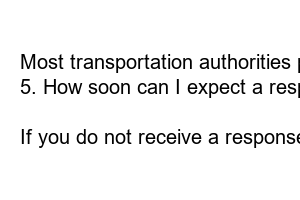지하철 민원문자
Title: Subway Complaint Letter: Speaking up for a Better Commuting Experience
Subheading 1: Introduction
Are you tired of experiencing constant delays, overcrowding, and subpar service during your daily subway commute? You’re not alone! It’s time to voice our concerns and make a change.
Subheading 2: Sharing My Subway Experience
Last week, I had yet another frustrating encounter with the subway system. Delays, abrupt breakdowns, and a lack of communication left me feeling exasperated. Determined to take action, I decided to write a complaint letter to address these issues.
Subheading 3: Importance of Expressing Our Concerns
By submitting a subway complaint letter, we send a powerful message to the authorities, demanding improved infrastructure, better services, and more reliable schedules. Our voices need to be heard, and our concerns addressed promptly.
Subheading 4: The Art of Writing a Subway Complaint Letter
When writing your subway complaint letter, it is essential to be concise, persuasive, and articulate. Clearly state the issues you have faced, providing specific instances and dates. Use a friendly yet assertive tone that conveys your urgency for change.
Subheading 5: Addressing Common Subway Problems
1. Excessive Delays: These frustrating delays disrupt our schedules and affect productivity throughout the city. Proper maintenance, increased funding, and efficient communication channels can mitigate this issue.
2. Overcrowded Trains: The persistent overcrowding not only compromises comfort but also raises safety concerns. Expanding train capacity during peak hours and implementing crowd management strategies can alleviate this problem.
3. Inadequate Facilities: Filthy stations, malfunctioning escalators, and non-functional elevators are common complaints. Regular maintenance and investment in renovations will ensure passenger safety and convenience.
Subheading 6: The Power of Collective Action
To amplify our concerns, it is crucial to encourage fellow commuters to write complaint letters and join forces in our fight for improvement. Utilize social media platforms, community forums, and word-of-mouth to foster a sense of unity, inspiring others to speak up.
Subheading 7: Summary of the Article
In this blog post, we explored the importance of writing a subway complaint letter to address the persistent issues plaguing our daily commutes. By expressing our concerns in a clear and persuasive manner, we can make a collective impact and drive positive change in our subway system.
FAQs:
1. How do I address the complaint letter?
When addressing the complaint letter, use a formal, salutation such as “To whom it may concern” or “Dear [Transportation Authority].”
2. What supporting evidence can I include?
Include specific instances, dates, and even photographic evidence of the issues you have encountered during your subway commute.
3. How long should the complaint letter be?
Keep the complaint letter concise and to the point, preferably within one page. Focus on highlighting the key issues and proposed solutions.
4. Can I submit the complaint letter electronically?
Most transportation authorities provide online platforms for submitting complaints. Check their website or contact their customer service for further guidance.
5. How soon can I expect a response?
Response times may vary, but it is reasonable to expect a timely acknowledgment within a week or two. In cases of emergencies or safety concerns, swift action should be taken by the authorities.
6. What if my complaint goes unanswered?
If you do not receive a response within a reasonable time frame, escalate your complaint by contacting higher authorities, such as the mayor’s office or local representatives, to ensure your voice is heard.

